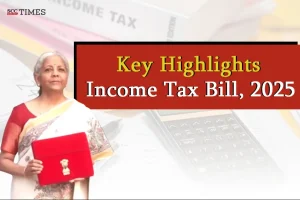The Union Finance Minister, Nirmala Sitharaman, proposed the new Income-tax Bill, 2025 proposing to repeal and replace the Income-tax Act, 1961. This effort is to make the Act concise, lucid and easy to read and understandable which will help in reducing disputes, litigations and provide clearer tax certainty to tax payers.
The Bill was first introduced during the 2024 Budget which has been now approved by the Union Cabinet on 7-2-2025. This bill, once passed by both the Houses, will replace a 6-decade old legislation and will come into force on 1-4-2026. Earlier, the Income-tax Act 1961 contained 298 Sections and 14 Schedules and However, the new bill contains 536 clauses and 16 Schedules which show its comprehensive nature.
Key Highlights of Bill:
-
Definition of “books or books of account” has been revised which increases the ambit of data stored in electronic form and includes the data stored on cloud-based storage, on any electromagnetic data storage device, such as floppy, disc, tape, portable data storage device, external hard drives, or memory cards.
-
Concept of “Crypto assets” has been introduced.
-
Introduces the “Finance Companies” and “Finance Units” in the context of Dividends.
-
Introduced “Taxpayer’s Charter” which will be adopted by the Central Board of Direct Taxes (‘CBDT’) and will issue orders, instructions, directions and guidelines to other income-tax authorities for the administration of this Charter. This will help in enhancing transparency and taxpayers rights.
-
CBDT is empowered to frame rules, introduce compliance measures and enforce digital tax monitoring systems.
-
With this Bill, the meaning of accountant has been restricted to a Chartered Accountant which means that the tax audit will be conducted by Chartered Accountants only.
-
Until now, the terms assessment year and financial year were used for filing and depositing tax which used to confuse the taxpayers, hence the bill has proposed the concept of tax year which will begin on or after 1st or April.
-
The concept of the financial year will remain the same i.e. starting 1st April and ending on 31st March.
-
The residency will still be categorized under 3:
-
Ordinarily Resident individuals;
-
Non- ordinarily resident individuals;
-
Non- resident individuals.
-
-
All the Deductions from Salaries have been tabulated at one place for the benefit of taxpayers.
-
Chapter XIX specifies Tax Deduction at Source (‘TDS’) which has all the compliances, conditions that are applicable to TDS. Two different tables have been formulated tabulating the heads for “No deductions at source” and “Declaration for tax deduction at source”.
The new Income-tax Bill, 2025 is structured into 23 Chapters and 16 Schedules:
-
Chapter I- Preliminary
-
Chapter II- Basis of Charge
-
Chapter III- Incomes which do not form part of total income
-
Chapter IV- Computation of total income
-
Chapter V- Income of Other Persons, included in total income of assessee
-
Chapter VI- Aggregation of Income
-
Chapter VII- Set off, or carry forward and set off of losses
-
Chapter VIII- Deductions to be made in computing total income
-
Chapter IX- Rebates and reliefs
-
Chapter X- Special provisions relating to avoidance of tax
-
Chapter XI- General Anti-Avoidance Rule
-
Chapter XII- Mode of payment in certain cases, etc.
-
Chapter XIII- Determination of tax in special cases
-
Chapter XIV- Tax Administration
-
Chapter XV- Return of Income
-
Chapter XVI- Procedure for assessment
-
Chapter XVII- Special provisions relating to certain persons
-
Chapter XVIII- Appeals revision and Alternate Dispute Resolutions
-
Chapter XIX- Collection and Recovery of tax
-
Chapter XX- Refunds
-
Chapter XXI- Penalties
-
Chapter XXII- Offences and Prosecution
-
Chapter XXIII- Miscellaneous

